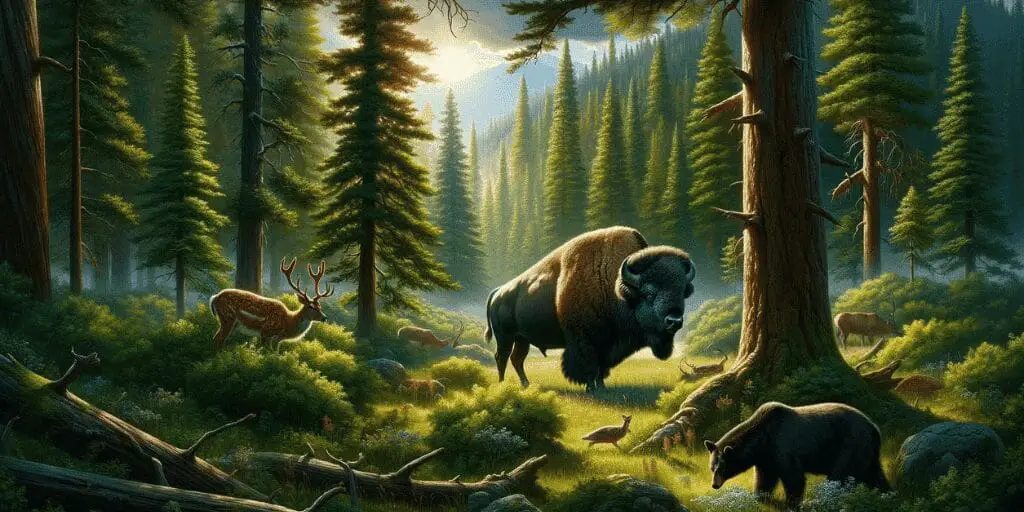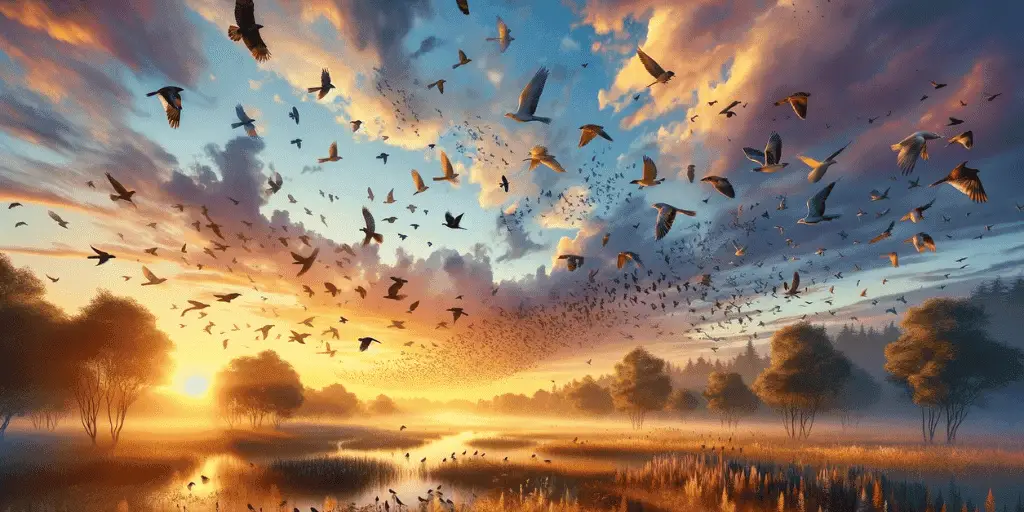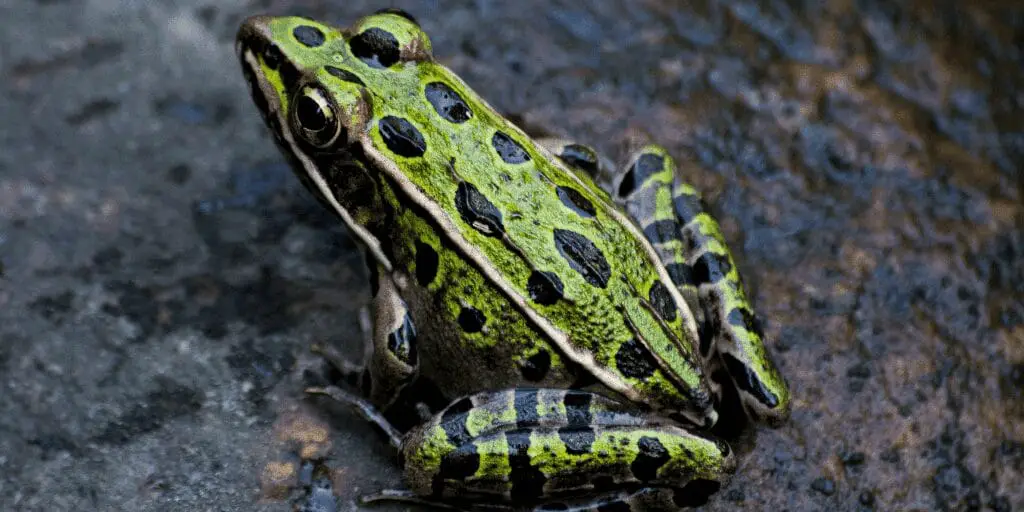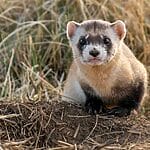Oklahoma has an amazing variety of wild animals across its prairies, forests, mountains, and wetlands. You can see bison, deer, otters, bears, prairie chickens, lizards and more. These animals are important to the local ecology. Different habitats in the state support different types of wildlife.
This article explores interesting mammals, birds, reptiles, amphibians and insects found in Oklahoma. It shows why wildlife is important here and how habitats are conserved. The goal is to showcase Oklahoma’s rich biodiversity. Read on to learn about local animals you may one day see for yourself!
Key Takeaways:
- Oklahoma has extremely diverse animal life across various ecosystems like prairies, forests, and wetlands
- Iconic wildlife species found in the state include bison, white-tailed deer, bald eagles and prairie rattlesnakes
- Many birds migrate huge distances to nest and feed in Oklahoma seasonally, like pelicans and red-tailed hawks
- Protecting habitats from threats like urban expansion is crucial to conserving vulnerable species
- Insects like monarch butterflies and tarantulas fill vital ecological roles in controlling pests and pollinating
List of Animals in Oklahoma
Quick Answer: Oklahoma has extremely diverse wildlife across prairies, forests, mountains and wetlands, including bison, deer, bears, bald eagles, pelicans, prairie chickens, chorus frogs, and tarantulas. These species fill crucial ecological roles, so conservation groups protect their habitats from threats like urban expansion.
| Category | Details |
| Mammals | Home to diverse species like American bison, black bears, white-tailed deer, bobcats, and coyotes. Bison roam the prairies, while bears and bobcats inhabit dense forests. |
| Birds | Over 450 bird species including the scissor-tailed flycatcher, bald eagles, American white pelicans, and red-tailed hawks. Oklahoma is a crucial habitat for both resident and migratory birds. |
| Reptiles | Eastern collared lizards and timber rattlesnakes represent the rich reptile life. Oklahoma’s waterways are home to American alligators and the prairies to prairie rattlesnakes. |
| Amphibians | Supports diverse amphibian species like American bullfrogs, barred tiger salamanders, eastern newts, and gray treefrogs. Amphibians play a crucial role in local ecosystems. |
| Insects and Arachnids | Insect life includes monarch butterflies, black widow spiders, and honeybees. Tarantulas are among the arachnids found in Oklahoma’s varied habitats. |
1. Majestic Mammals of Oklahoma

Oklahoma is home to a remarkable diversity of mammal species, from the imposing American bison to the elusive black bear. These mammals occupy a variety of habitats across the state, from tallgrass prairies to dense forests, and play integral roles in local ecosystems.
While some species like white-tailed deer are a common sight, others remain out of view, but their presence is felt through their impacts on the landscape.
Bison – The Iconic Prairie Dweller
American bison are an iconic symbol of the Great Plains, and they once roamed Oklahoma’s vast tallgrass prairies in great numbers. Although overhunting decimated their populations in the 1800s, conservation efforts have allowed bison to recover somewhat within the state.
The Tallgrass Prairie Preserve provides glimpses of these majestic beasts grazing across nearly 40,000 acres of protected grasslands. Bison prefer open grasslands and their intensive grazing helps maintain prairie habitats. They form large herds with complex social structures. Visitors may spot small groups of bison bulls congregating as they enter their rutting season.
White-tailed Deer – A Common Sight
White-tailed deer can be found across most of Oklahoma, as they are highly adaptable and occupy forests, woodlands, farmlands, and even suburban areas. They play an important role in local ecosystems, influencing the growth and composition of vegetation through their grazing.
Their populations must be carefully managed to prevent overbrowsing of native plants. White-tailed deer display noticeable seasonal cycles in their behavior. In spring and summer, females isolate themselves before giving birth, while in fall males roam more widely and clash antlers to establish dominance during the breeding season.
Black Bear – The Forest’s Secret Inhabitant
The American black bear is a reclusive creature that dwells in Oklahoma’s dense oak and pine forests, primarily found across the Ouachita Mountains. They are omnivorous foragers, using their keen sense of smell to root through fallen logs and vegetation in search of fruits, nuts, berries, insects, and occasionally small mammals.
Black bears prefer to avoid humans, but encroaching development has increased problematic bear-human encounters. Conservation education and the protection of remote woodland habitat help preserve populations of this elusive creature and minimize conflicts.
Bobcat – The Stealthy Predator
Bobcats inhabit wooded regions across most of Oklahoma. They are adept stealth hunters, surprising prey with sudden bursts of speed and lethal pounce attacks. As a top predator, the bobcat plays an important ecological role in regulating populations of small mammals like rabbits and rodents.
Solitary and territorial, bobcats are active mostly during twilight hours, using their acute vision and hearing to hunt under cover of darkness. Their elusive nature makes bobcat sightings rare events for humans. Preserving connectivity between forest habitats ensures this species persists across the Oklahoma landscape.
Coyote – The Adaptable Canine
The coyote is one of Oklahoma’s most adaptable mammal species. They thrive across a wide range of habitats from prairies to suburbs. Coyotes play an important ecological role and their rodent-rich diet likely helps suppress pest populations. Clever and opportunistic carnivores, coyotes have expanded their numbers and range across Oklahoma in recent decades.
They can sometimes create conflicts with humans, but education and appropriate precautions can reduce problems. Their iconic howls continue to symbolize the wild spirit of the American West for many. Managing coexistence with the highly adaptable coyote poses an ongoing challenge for state wildlife authorities.
2. Birds of a Feather: Oklahoma’s Avian Wonders

Oklahoma provides essential habitat for over 450 bird species across its diverse landscapes, from sweeping prairies to shimmering wetlands. Many avian species migrate huge distances to nest and feed in the state before heading south again for winter.
Local birds range from the graceful state symbol, the scissor-tailed flycatcher, to great horned owls that rule the skies after dark with their imposing silhouettes.
Several locations around the state offer prime birdwatching, attracting enthusiasts keen to spot both resident species like red-tailed hawks and seasonal visitors like the striking American white pelican. Community efforts help preserve habitats needed to sustain vibrant and varied bird populations.
Scissor-tailed Flycatcher – The Graceful State Bird
The scissor-tailed flycatcher flaunts its distinctive twin tail feathers across Oklahoma’s open prairie country. Perching atop fence posts and utility wires, these slender gray birds set out to snatch insects from midair.
Come spring, males perform dramatic courtship rituals, spreading their tails and wings while a distinctive “wicka-wicka” call echoes across grasslands. The best opportunities to observe them occur at places like the Wichita Mountains Wildlife Refuge from April through June.
Bald Eagle – America’s Symbol in the Sky
The bald eagle has made an inspiring comeback in Oklahoma after its population crashed from hunting and pesticides. Today these iconic raptors nest around waterways statewide and frequented locations include the Illinois River and Lake Texoma.
From November to March, travelers can observe them feeding on fish and waterfowl drawn to the same waters that attract migrating ducks and geese. Seeing a bald eagle majestically descend from the skies remains a moving experience for any nature lover.
American White Pelican – The Migratory Visitor
American white pelicans visit Oklahoma’s lakes and wetlands during their annual migrations between the Pacific and Gulf coasts. These striking birds work cooperatively and form flocks of hundreds gliding in unison just above the water’s surface.
Plunging their pouched beaks in unison, they corral fish into the shallows for easy scooping. The Salt Plains National Wildlife Refuge and Waurika Lake provide excellent spots to admire these seasonal occupants and observe their remarkable team tactics firsthand during migrations in April and November.
Red-tailed Hawk – The Soaring Predator
No bird embodies the spirit of the wide-open American plains quite like the red-tailed hawk with its trademark rusty tail. These powerful raptors cruise over fields and grasslands watching intently for any sudden movements that betray the presence of mice, snakes or other prey below.
Not just scavengers, red-tails contribute to maintaining healthy small animal populations as they help prevent fast-breeding rodent numbers from spiraling out of control. Look for these birds perched on telephone poles adjacent to highways and open areas statewide.
Great Horned Owl – The Nocturnal Hunter
The great horned owl reigns as Oklahoma’s top nocturnal predator, possessing outstanding night vision and hearing. Mostly unseen by day, these birds emerge at dusk to hunt rabbits, mice, snakes, and even skunks from high vantage points before swallowing their catch whole.
Their low hoots are a regular feature of nighttime forest walks statewide. To catch a glimpse of a great horned owl, concentrate efforts around dawn and dusk when activity peaks. With luck, visitors may spy one returning to roost just before sunrise.
3. Reptilian Inhabitants: Snakes, Lizards, and More

Oklahoma contains remarkable diversity among its cold-blooded reptile residents. Lizards dart through rocky deserts and snakes slither stealthily through lush wetlands. These creatures fill vital ecological roles, helping control pest species while also serving as prey for other wildlife.
Venomous serpents command healthy respect and proper identification of these misunderstood predators can save lives. Taking appropriate precautions makes it possible to safely enjoy glimpses into the world of these fascinating reptiles.
Eastern Collared Lizard – The Colorful Desert Dweller
Few sights quicken the pulse more than witnessing the males of this species displaying in spring. Eastern collared lizards earn their name from the vibrant black and yellow bands circling their necks. The remainder of their bodies pulses with an array of yellows, blues, and greens.
These social lizards gather to mate after emerging from winter hibernation. Males battle rivals before courting females. These agile reptiles inhabit broken terrain with rock crevices to hide in and sprint up to 18 miles per hour when chasing insect prey or eluding danger!
Timber Rattlesnake – A Misunderstood Predator
The timber rattlesnake plays a crucial role in controlling rodent populations but remains unjustly feared. These venomous pit vipers inhabit remote woodlands statewide. Identifiable by dark chevrons down their length, they can reach over 5 feet in size. Their hemotoxic venom helps immobilize small mammal prey like rabbits and squirrels.
Bites require rapid medical intervention but most snakes avoid conflict when possible. Never threaten or attempt to handle a venomous snake – calmly retreat from any close encounters. Protecting remote forest habitats ensures balanced coexistence can continue.
American Alligator – The Wetland’s Apex Predator
American alligators lurk in Oklahoma’s swamps and bayous biding their time to ambush terrestrial creatures that stop for a drink. Males can reach over 11 feet and create thunderous bellows to attract mates and advertise territory.
Playing a vital role curbing populations of species like nutria and raccoons, alligators help maintain healthy wetland ecosystems.
But increasing habitat loss jeopardizes their future. Recent conservation measures expanded protected wetlands statewide, but responsible development around these areas remains crucial to safeguard the alligator’s future in Oklahoma.
Prairie Rattlesnake – The Grassland Sentinel
The prairie rattlesnake occurs statewide where there remain remnants of intact grasslands and scrublands for them to hunt rodents and nest in underground burrows. Their hemotoxic venom makes bites hazardous, but these snakes play important ecological roles, and most bites happen when humans threaten or try handling them.
Responsible land development coupled with public education programs emphasizing safety precautions over persecution help ensure balanced coexistence with these venomous predators.
Common Collared Lizard – The Vibrant Rock Dweller
The common collared lizard exhibits incredible sprinting and climbing talents aided by its long toes and ridged tail. Ranging from olive to bright turquoise in color, these active foragers inhabit rocky outcrops with crevices to hide in statewide. Males bob their heads in territorial displays or to court females.
These striking lizards contribute to pest control and represent an iconic Southwest species. While losing habitat to urban sprawl, protected wildlife corridors between public lands offer hope for the collared lizards’ future in Oklahoma.
4. Amphibians: The Overlooked Treasures of Oklahoma

Oklahoma’s diverse landscapes support a remarkable array of amphibians, from chorus frogs trilling through wetland fens to tiger salamanders hiding in underground burrows. These creatures play vital ecological roles during their complex life cycles which see them transform from water-bound larvae to terrestrial adults.
Amphibians represent essential indicators of environmental health, as pollution and habitat loss hit them hard. State agencies now recognize their importance and work actively to monitor populations and safeguard precious remaining habitats statewide.
American Bullfrog – The Boisterous Pond Resident
The deep bellowing calls of male bullfrogs represent an iconic sound of warm Oklahoma summer nights. These large amphibians inhabit ponds and other still waters statewide where they ambush smaller animals with their sticky tongues, including insects, fish, young turtles, and even baby alligators!
Their tadpoles help sustain fish populations. While bullfrogs end up as prey for wading birds and snakes, maintaining adequate buffer zones around wetlands gives the next generation of these voracious amphibians space to mature.
Barred Tiger Salamander – The Burrowing Marvel
Few amphibians live farther from water than the barred tiger salamander which spends most of its life underground in elaborate burrows. Emerging at night or during rainfall, these stocky salamanders forage for worms, slugs and insects across forest floors and grasslands.
Successful reproduction depends upon the availability of specific temporary pools to lay eggs during wet seasons. Reduced groundwater levels place increasing strain on remaining viable sites. Protecting lands around known breeding sites offers the best chance for conserving salamander populations.
Eastern Newt – The Aquatic and Terrestrial Amphibian
The eastern newt has a complex life cycle alternating between aquatic and land habitats. Their semi-permeable skin makes newts highly sensitive to changes in moisture or pollution levels – a key reason for monitoring them.
Newts hatch as herbivorous aquatic larvae before transforming to utilize more terrestrial prey like insects and worms as adults. Ensuring connectivity between aquatic and forest habitats allows new populations to shift as needed to find food and moisture at different life stages.
Gray Treefrog – The Camouflaged Climber
The gray treefrog sports remarkable camouflage allowing it to disappear against woody backgrounds. A tiny suction pad on each toe allows these agile amphibians to climb vertical surfaces. Living primarily in forests, they descend to breed in temporary rain-filled pools and roadside ditches.
Continuing wetland drainage poses serious threats to future population stability. Preserving intact canopies around seasonal wetlands offers the best prescription for safeguarding gray tree frogs in years to come.
Spotted Chorus Frog – The Rain Caller
When warm spring rains arrive, the loud ringing calls of male spotted chorus frogs emerge from wetlands and flooded ditches statewide. These diminutive amphibians gather by the dozens to find mates in ephemeral waters. Successful reproduction depends on how long pools persist before drying.
Protecting low-lying grasslands from drainage provides essential breeding habitat. Visitors exploring wetlands as chorus frogs breed may witness a spirited amphibian spectacle as males wrestle over the best spots to advertise for females.
5. The Buzzing Life: Insects and Arachnids in Oklahoma
Insects and arachnids often go overlooked, yet they fill absolutely vital roles across Oklahoma’s habitats. Creeping, crawling, and buzzing everywhere from backyards to sweeping grasslands, these tiny creatures form crucial food sources for other wildlife while providing pest control, pollination, and more.
However, many species now face huge challenges from habitat loss and indiscriminate pesticide use. Supporting local conservation efforts and making small changes around homes and gardens can aid spiders, butterflies, bees, mantises, and the myriad other small animals that collectively make up the backbone of local ecosystems.
Monarch Butterfly – The Migratory Pollinator

The monarch butterfly’s brilliant orange and black wings make it one of the most easily recognized insect species anywhere. Monarchs depend completely on milkweed plants where females lay the next generation’s eggs.
Caterpillars feed only on milkweed making it vital to protect the remaining prairie tracts that still support this plant. Adult monarchs fly south to overwinter in Mexico and California before migrating back north in spring. Supplying nectar through flower plantings aids migrating butterflies on their epic multi-generational round trips.
Black Widow Spider – The Misunderstood Arachnid
The black widow spider prefers dark corners in quiet, sheltered spots where they construct messy-looking webs to catch insects and occasionally small vertebrates wandering too close.
Despite their fearsome reputation, black widows reclusively avoid contact whenever possible, delivering venomous defensive bites only as a last resort. Their presence helps indicate habitats free of widespread chemical disturbance. Leaving woodpiles and debris undisturbed provides refuge for these beneficial arachnids to make their homes and continue quietly controlling pests.
Praying Mantis – The Stealthy Predator
With their spiked raptorial front legs and ability to rotate their heads to scan for prey, praying mantises represent consummate predators. Ranging from drab green to pastel pink, these formidable insects consume insects and even small vertebrates like frogs, lizards, and hummingbirds.
Native mantises fill a special niche in controlling pest numbers making gardens friendlier for pollinators like bees and butterflies. Leaving some vegetation thickets and leaf litter undisturbed preserves the critical microhabitats these iconic predators rely on.
Honeybee – The Essential Pollinator
Bees form the backbone of agricultural and natural ecosystem stability through their unmatched pollination services enabling plants to reproduce. Yet bees suffer severe threats ranging from disease to habitat loss.
Home gardeners can make a real difference by cultivating pollinator-friendly plant varieties and avoiding pesticide usage. Seeking out locally produced honey also aids regional beekeepers working to maintain healthy hive numbers. Ensuring bees thrive again helps guarantee future harvests of Oklahoma’s diverse produce.
Tarantula – The Gentle Giant
Despite often reaching 5 inches long, tarantulas tend to live solitary and unassuming lives hunting insects, frogs, and small rodents under cover of darkness. Their size and hairiness cause unjustified alarm when these spiders just want to be left alone.
Tarantulas help control nuisance insects and their tunnels aerate soils. Hands-off observation allows the best views of tarantulas going about their business. Ensuring intact connectivity between the scrublands, deserts, and canyons tarantulas inhabit preserves populations of Oklahoma’s most imposing eight-legged residents.
Conclusion: Protecting Oklahoma’s Wildlife
Oklahoma has many types of wild animals living across different habitats like prairies, forests, and wetlands. These animals are important parts of local ecosystems. Bison, deer, bears, birds, frogs, and insects all play roles in keeping habitats healthy.
But many wild places are disappearing due to human activity. Animals are losing their homes. Some species are now vulnerable and need help to survive through conservation projects. These projects protect habitats and responsibly manage land use.
Everyone can get involved with saving Oklahoma’s wildlife. We can support conservation groups, make sustainable choices, learn how to safely live near wildlife, and teach others about these important animals. By working together, maybe we can protect species and habitats for future generations.
I hope reading about Oklahoma’s amazing variety of wildlife inspires people to help ensure these animals continue to thrive. Each one contributes to the state’s rich natural heritage. If we act now, even small efforts from individuals can make a big difference.
- 6 Animals That Are Not Mammals - 2024-04-28
- 9 Common Dangerous Animals In Virginia - 2024-04-28
- Are Koalas Smart? - 2024-04-28









